
Welcome
Welcome to Whippoorwill Acoustics. We build and sell the finest autoharps and kalimbas, and provide resources for autoharp players. For me, building musical instruments combines elements of my education (physics), vocation (systems engineering, modeling and simulation), avocation (wood-working), and recreation (playing music). It is the implementation of sound principles of acoustics and structural mechanics using premium woods, careful joinery, quality craftsmanship, esthetic design, and the finest wood finishes. My goal is to build instruments that are beautiful to see, desirable to hold, wonderful to hear and enjoyable to play. What could be more fun?

“Every piece of wood is a work of art”
Ken Ellis

Ken Ellis
Luthier
Whippoorwill Acoustics autoharps feature:
High dynamic range. Dynamic range is the ratio of loudest to softest sound. A larger dynamic range lets you play more expressively. Even response from bass through treble. Whippoorwill Acoustics autoharps are notable for the enhanced bass relative to other autoharps. This gives them a nice even response so that notes can be easily played at about the same volume whether they are in the bass, treble, or midrange. Good note separation. Note separation gives listeners the ability to distinguish notes that are played simultaneously, an advantage for making fast runs sound cleaner and making the melody sound distinctly over background chords. Less dead string noise. When you accidentally pluck a string that is damped by the felt, you get a clack that detracts from the beautiful sound of the open strings. Our proprietary process of customizing bracing for every autoharp results in significantly less dead string noise than any other autoharp brand. Low-profile chord bar holders for a shorter reach around the autoharp. Light Weight. Whippoorwill Acoustics autoharps are noticeably lighter than most other luthier autoharps and significantly lighter than factory-built models. This reduces fatigue while playing and makes it easier to schlepp your gear to your jam. French polish finish. French polish is the traditional finish used on premium classical guitars. The French polish is best for bringing out the beauty of the wood, giving the grain a 3-D appearance. It is also a very thin finish, allowing an instrument to vibrate freely so that it produces the best sound. Ebony chord bar buttons large enough for my fat fingers. The polished ebony provides a tactile experience while playing, which complements the feel of the French-polish finish. Integrated headrest to prevent the back from being scratched, without relying on those rubber feet that always fall off and get lost. Quarter-sawn wood. The exclusive use of quarter-sawn wood for all elements that affect the sound produces the best sound due to its uniform response to vibrations. Quarter-sawn wood is also the most stable wood, making the resulting instruments easier to keep in tune while minimizing the possibility of developing cracks with humidity changes. Hand-carved bracing for the most beautiful sound and the shortest "playing in" time. Customized voicing. Using the results of acoustical testing, the positions of the braces and sound hole in every autoharp are customized for the actual acoustical properties of the individual pieces of wood used for the top and back. The acoustical properties of wood from the same plank can vary by as much as 30%, making it difficult to get a consistently wonderful sound from one instrument to the next. By customizing the bracing and soundhole for every piece of wood, every Whippoorwill Acoustics autoharp has a rich, full sound, with the chromatic autoharps having a sound that approaches that of the diatonics. Whippoorwill Acoustics autoharps also have all the features that musicians expect from a luthier-built instrument: • All solid-wood construction • Fine tuners for easy tuning • Low, fast action • Custom wood choices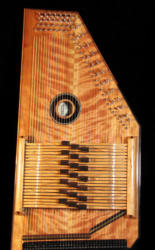
About Our Name
Our
name,
Whippoorwill
Acoustics
,
was
inspired
by
The
Whippoorwill
Song
and
is
a
tribute
to
the
Grande
Dame
of
the
autoharp,
Patsy
Stoneman,
who
passed
away
in the
summer
of
2015.
It
was
one
of
Patsy's
signature
songs,
which
we
enjoyed
hearing
each
time
we
had
the
privilege
of
seeing
her
perform
at
the
Mountain
Laurel
Autoharp
Gathering.

About Our Luthier
In the shop
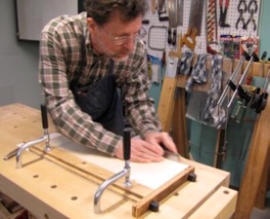
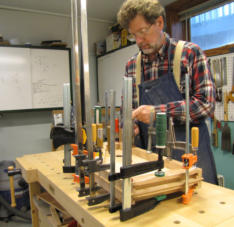
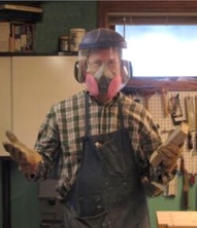
Joining an autoharp back with a shooter
board. A tight joint is key to keeping the
seam from opening up.
You can never have too many clamps.
Ready for light sanding, wearing
the protective gear recommended
by lawyers from the sandpaper
manufacturer.
In the acoustics lab
There
is
plenty
of
information
out
there
about
how
to
build
a
good
musical
instrument.
However,
nobody
really
understands
why
some
instruments
have
exceptionally
good
sound
while
seemingly
identical
instruments
are
only
average.
Or
maybe
they
do
and
are
not
telling.
Our
instruments
are
based
on
the
work
and
the
knowledge
of
my
predecessors
and
colleagues,
who
have
been
more
than
generous
with
their
advice,
supplemented
by
results
from on-going experiments in our acoustics lab.
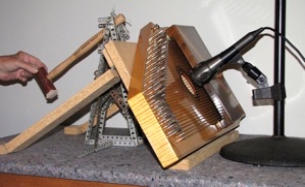
The
acoustical
properties
of
every
piece
of
wood
are
different,
even
for
two
pieces
of
the
same
size
from
the
same
tree.
The
top
and
back
of
each
Whippoorwill
Acoustics
autoharp
are
tested
in
the
acoustics
lab
so
that
the
bracing
and
soundhole
position
can
be
tailored
to
get
consistently
good
sound,
dynamic
range,
and
note separation.
Measuring the acoustical properties of an
autoharp
After 34 years of being a research engineer and scientist for aerospace companies, Ken left a good job in the city,
workin’ for the Man every night and day. As it turns out, those years combined with his music and woodworking
hobbies were good preparation for building acoustic musical instruments, bringing a systems engineering and
analysis approach to the problem of understanding the physics of acoustics. That and his irritating ability to
continually ask “why does it do that” and “how does this work?”, questions that led to his regular column on the
subject in the Autoharp Quarterly and to conclusions that affect the sound of our instruments.
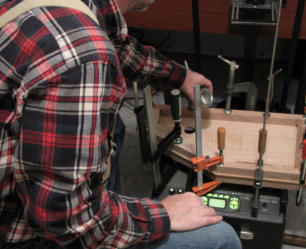
Sprinkling salt on a vibrating top to
visualize the vibration modes.
© Whippoorwill Acoustics LLC, 2015-2023


















